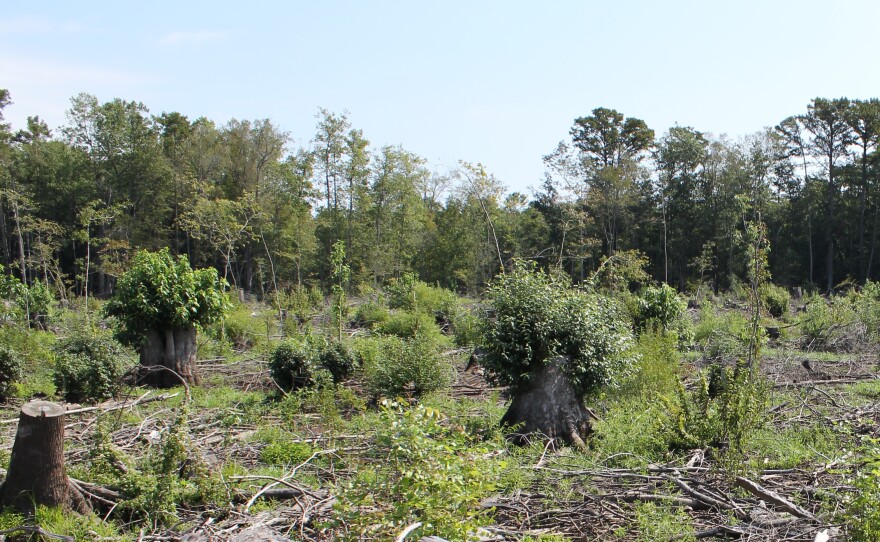The European Union is pushing member states to go green -- offering incentives and requiring that utilities cut their carbon emissions and increase their use of renewable energy sources by 20%. That sounds like a noble goal, but it may be having unintended consequences in Virginia and neighboring states – consequences that have some environmentalists up in arms.
Derb Carter is an avid birder who uses recordings to draw birds toward his binoculars in a forest along the Roanoke River in Eastern North Carolina. “Birds are territorial, and if the bird thinks there’s another red bellied woodpecker in the territory, he or she will come in to inspect.”
And sure enough, a red bellied woodpecker shows up. Carter is pleased, but he worries about the future of birds like this one.
“Thirty species of migratory songbirds – they’re rare, declining or some actually listed as threatened or endangered -- are dependent on these bottomland hardwood forests.”
And the forests are coming down – perhaps because demand is heating up, as European power plants switch from coal to wood. Elizabeth Woodworth is with Bethesda-based Enviva, the nation’s largest maker of wood pellets.
“We use low grade byproducts of other lumber industries – so industries that are making furniture and flooring and railroad ties, etc, and that includes saw dust, wood chips, tops and limbs of trees that otherwise wouldn’t have another market," says Woodworth.
And, she says, about 25% of its raw materials comes from whole trees that are too small, crooked or diseased to be used as lumber, or from managed forests.
“They thin out smaller or defective trees out of a forest to ensure that the higher value trees have the sunlight and the nutrients to grow as tall as possible," she says.
But after multiple visits and flights over Enviva mills, the Southern Environmental Law Center believes the company, which has three plants in Virginia and North Carolina, depends primarily on whole trees – some of them 80-100 years old, clear cut from bottomland forests.
Outside this pellet mill, 135 miles east of Durham, a steady stream of trucks arrives loaded with logs. They’re piled 30 feet high, waiting to be chopped up and pressed into pellets. Bird lover Derb Carter, who is also a senior attorney with the Southern Environmental Law Center, has shared pictures of the site with officials at the European Union, who believed pellets were coming from forests that were sustainably managed.
"In the Southern United States, 87% of the forest is privately owned. There’s no requirement that you get a permit or authorization to cut a forest. You don’t have to replant a forest, and in fact we continue to lose forest at an alarming rate to urbanization and development and other uses.”
Enviva says it only takes wood from working forests – not from preserves or properties being developed, and gets GPS coordinates from truckers, so it can trace the wood coming in.
“In addition, our suppliers, our loggers are contractually required by Enviva to comply with all best management practices which are developed and implemented by the state forest service to ensure that forest operations do not have a negative impact on water quality of sensitive ecosystems of habitats.”
Woodworth adds that the land in question has been harvested before, and hardwood forests are not being cut solely for wood pellets, a claim echoed by Charlie Becker with Virginia’s Department of Forestry.
“Pellets and pulp tend to be lower value products, and if you own something, you want to get the most money out of it that you can, so you wouldn’t take high quality wood that could be used for furniture or veneer or nice building construction and have it ground up and put into a low value product.”
Still, being able to sell lower quality wood along with high quality trees makes it more profitable for landowners to harvest their trees, and demand for pellets has risen dramatically. Exports last year were up 70%.
Becker says a strong market for wood actually protects forests, since landowners are less likely to convert them to farms or subdivisions if they’re generating occasional revenue, and with proper management hardwood forests grow back. Young trees absorb more carbon than the old ones, and while the new woodland evolves, wildlife goes elsewhere.
“Unless it’s very critical forest for very critical wildlife, they’re just going to move over to the adjacent forest.”
To a point, says Derb Carter, but when large amounts of habitat are lost, populations drop, and SELC predicts a lot of forest will be cut over a 25-year period to supply the pellet industry.
“These facilities would require harvesting about 750 square miles of forest, which is almost the size of the Great Smokey Mountains National Park. The state of North Carolina is in the process of making a decision to build facilities at each of the state ports -- Morehead City and Wilmington – to export pellets to Europe.”
Concerns about wildlife aside, Derb Carter wonders if this whole approach to mitigating climate change really makes sense.
“We’re cutting forest over here, which requires energy, processing them into pellets, transporting them to a port, putting them on a boat burning diesel fuel to haul them all the way across the Atlantic to again transport them to a utility to burn instead of coal.”
Enviva says it’s taken all those things into account and wood still comes out better than coal when you’re talking about carbon dioxide emission, but trees normally store carbon, and when they’re burned, it’s released. What’s more, Carter says this renewable resource grows back slowly. “That’s going to take 80 to 100 years to occur, and because it takes more wood than coal to create the same amount of energy, we’re actually going to be putting much more carbon into the atmosphere for many decades than we would if we burned coal.”
The Virginia Department of Forestry continuously monitors the state’s woodlands, and Charlie Becker says government programs and other assistance could be expanded if too much forest is lost.
“I mean we are concerned with the sustainability, and this is why we track.”
In the mean time, the European Union is assessing the sustainability of wood pellets – planning to issue a report early next year. Unless its policy changes, experts say pellet exports from the Southeastern United States will double by 2016.




